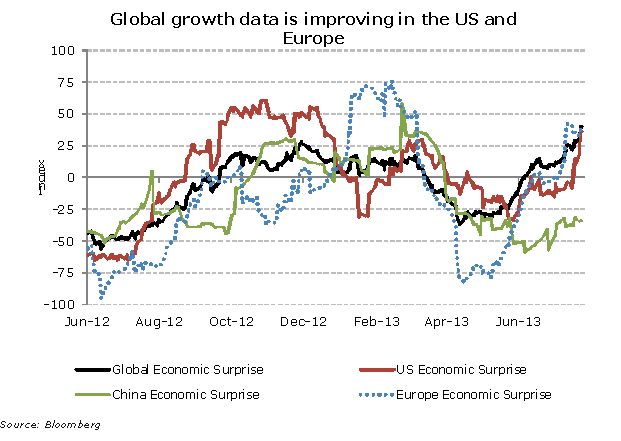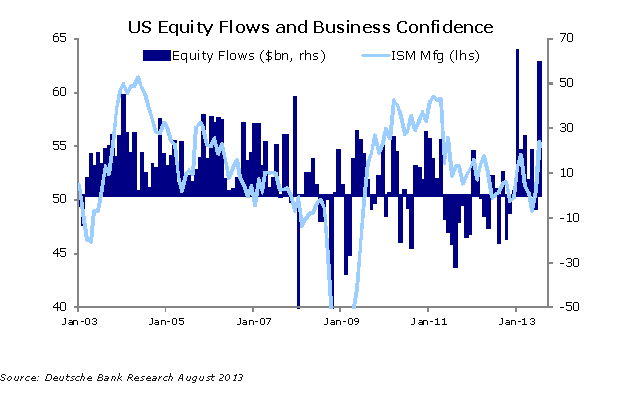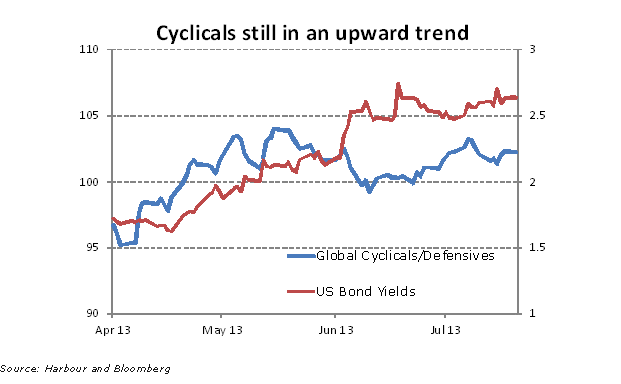A little less stimulus ahead
Harbour Monthly Commentary: A more selective equities strategy may be the best approach for investors in the near future.
Wednesday, August 7th 2013, 12:17PM
by Harbour Asset Management
Equity returns are influenced by both earnings growth and valuations. While earnings growth is mostly affected by economic growth, valuations reflect a combination of investor thinking about volatility, longer term growth, inflation, interest rates and bond yields. In this mix, the potential for higher interest rates in New Zealand, coupled with the recent move higher in bond yields may begin to eat away at the bullish case for equity returns in New Zealand.
We are positive about economic growth, especially in New Zealand, but increasingly in the US and more broadly in the world economy. It is reasonable to debate rebalancing risks around growth in China, and about the prospects for growth in Europe. However, for the time being global growth forecasts look comfortable with some positive momentum.
In terms of risks, markets will continue to focus on the impact on bond yields of a tapering and the potential removal of policy stimulus. As we move towards September markets also have a number of other risks to consider including:
• Speculation on the next Federal Reserve Chair
• The result of the German elections where polls have tightened
• The potential for further US Sequestration cuts
• The chance of an early rise in interest rates in New Zealand
• The Australian election result, and,
• As growth improves the potential for an inflation scare
Growth momentum is certainly building
The surge in US business confidence - the PMI hit 55.4 in July - together with robust employment, suggests that the Fed is likely to start their tapering in September. This is now the consensus, and so the monetary policy debate is likely to move toward considering when will interest rates start to rise and how quickly (see Harbour Fixed Income report for July) .
The debate regarding a new Fed Chair will also become important. It seems most likely that the Fed will continue to smooth over the tension about QE tapering with guidance that interest rates will stay low for a long time, but there are risks to that view. In particular with US economic and employment growth lifting significantly there is increasing potential for a mild inflation scare, although inflation expectations remain well anchored.
The broader implication of stronger data in both Europe and the US is that tensions regarding fiscal policy and debt sustainability are abating slightly and markets can switch to focus more on growth fundamentals – or for the bears, switch to worrying about the packed schedule of policy risks in September.

Investor behaviour may be an over-riding determinant of the market in coming months. Historically investor flows have tended to be correlated with US business confidence. Equity inflows into US mutual funds have been strong for the past two months with over $54bn in net flows in the past 5 weeks. The US PMI is signalling significant US momentum. If this is backed over August with generally robust data we could expect stronger equity flows to continue.

Despite stronger growth the US looks set to maintain low rates throughout 2014, while Australia has just cut rates. In contrast higher interest rates are expected in New Zealand within 6 months.
Although commentators still talk about recovery in New Zealand, the fact is that New Zealand is well past recovery, economic growth is now strong across a number of sectors. The rising stimulus associated with Christchurch, strong housing and better migration data and much better business confidence data are all suggestive of the need to lift rates. The July NZ central bank Official Cash Rate review was the most hawkish in recent years with a specific reference that the "removal of monetary stimulus will likely be needed in the future" .
And so investment markets are beginning to lift their expectations for higher rates. In the last month New Zealand interest rate futures have risen 0.4% and New Zealand bond yields have crept higher, the NZ 10 year rate now at 4.2%.

The New Zealand dollar had also been trading much higher against the Australian dollar, up to highs of 89 cents, although this strength was more reflective of a weak Australian dollar than a strong kiwi dollar.
As a result macro effects are currently significantly impacting stock and sector returns. Higher bond yields across Australia and New Zealand and divergent monetary policies may serve to highlight different prospective sector outlooks. Strategists in New Zealand and Australia are increasingly cautious on defensive yield plays, while there is more interest in cyclical interest rate sensitive companies in Australia and globally facing companies in both markets.
In both countries globally facing stocks are benefitting from the combined impact of a faster US economy, reducing perceptions of risk around China and Europe, and probably more importantly, a lower New Zealand and Australian dollar.
Specific sectors and stocks that may see increasing investor interest include the resource and energy sectors and the globally oriented healthcare and industrial sectors with stocks like Fisher and Paykel, CSL and Amcor.

Outlook – stronger growth supportive of equities although increasingly a more selective approach may be needed
Markets have a stronger economic backdrop to consider. Equity returns continue to move higher anticipating stronger earnings growth in 2014 and beyond.
At the same time equity valuations are high – we say they are not stretched or in bubble territory. Equity valuations will be supported by stronger expectations of growth, but higher bond yields, the expectation of higher interest rates and the potential for policy uncertainty to increase in September are all more challenging factors.
The weight of money flowing into the global equity market is for now a major offset, and on current data trends we do not expect a broad sell-off in equities.
Our major message is to use periods of weakness to average into the equity market, and to be more selective in buying stocks with a cyclical or growth bias. Stocks and sectors exposed to either bond valuation or interest rate risk in New Zealand are more likely in our opinion to be challenged as the prospect of interest rates rising increases.
Important disclaimer information
| « Pathfinder Monthly Commentary | Hamish Douglass Unplugged - Latest Video from Adviser Briefing - August 2012 » |
Special Offers
Comments from our readers
No comments yet
Sign In to add your comment
| Printable version | Email to a friend |









